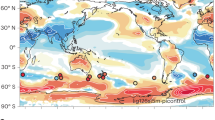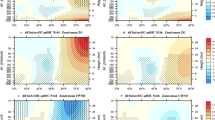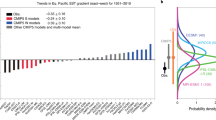Abstract
Air pressure at sea level during winter has decreased over the Arctic and increased in the Northern Hemisphere subtropics in recent decades, a change that has been associated with 50% of the Eurasian winter warming observed over the past 30 years, with 60% of the rainfall increase in Scotland and with 60% of the rainfall decrease in Spain1. This trend is inconsistent with the simulated response to greenhouse-gas and sulphate-aerosol changes2,3, but it has been proposed that other climate influences — such as ozone depletion — could account for the discrepancy3. Here I compare observed Northern Hemisphere sea-level pressure trends with those simulated in response to all the major human and natural climate influences in nine state-of-the-art coupled climate models over the past 50 years. I find that these models all underestimate the circulation trend. This inconsistency suggests that we cannot yet simulate changes in this important property of the climate system or accurately predict regional climate changes.
Similar content being viewed by others
Main
I derived a zonal index by subtracting the December–February mean sea-level pressure northwards of 45° N from the mean sea-level pressure between the Equator and 45° N using two data sets: the NCEP reanalysis4 and a newly completed data set of gridded observations known as HadSLP2r (R. J. Allan and T. J. Ansell, manuscript submitted). The trend in this zonal index over the period 1955–2005 is shown in Fig. 1 for both data sets. I compared the observed trend with output from nine coupled climate models from the Intergovernmental Panel on Climate Change data archive (UKMO-HadCM3, CCSM3, PCM, GFDL-CM2.0, GFDL-CM2.1, MIROC3.2(medres), MIROC3.2(hires), GISS-EH and GISS-ER).
The green line represents the 1955–2005 trend in the mean sea-level pressure in the Northern Hemisphere over December–February southwards of 457 N minus the mean sea-level pressure northwards of 457 N taken from the NCEP reanalysis4 and the blue line represents the same from the HadSLP2r data set (R. J. Allan and T. J. Ansell, manuscript submitted). The black line is a normalized histogram of 50-year zonal index trends in 3,903 overlapping segments of control simulations from nine coupled climate models obtained from the Intergovernmental Panel on Climate Change data archive of the Program for Climate Model Diagnosis and Intercomparison, Lawrence Livermore National Laboratory. The red line is a normalized histogram of 1955–2005 zonal index trends from 40 historical simulations of the nine models with anthropogenic and natural forcings. In cases where the historical simulations ended before February 2005, output from twenty-first century scenario integrations with only anthropogenic forcings was used for the missing years.
To assess whether the observed trend could result from internal climate variability, I calculated equivalent zonal index trends in 3,903 overlapping 50-year segments of the models' control integrations (Fig. 1, black histogram). The NCEP zonal index trend exceeds all 50-year zonal index trends from the control simulations, and the HadSLP2r zonal index trend exceeds all but one, indicating that the observed trend is inconsistent with simulated internal variability at the 5% significance level.
I assessed the possible role of external forcing by calculating zonal indices for the period 1955–2005 in historical simulations from the same climate models, which include greenhouse-gas, sulphate-aerosol, stratospheric-ozone, volcanic-aerosol and solar-irradiance changes. The resulting zonal index trends in each of the 40 ensemble members are shown by the red histogram in Fig. 1. Although the mean trend in these simulations is significantly positive (0.40 hectopascal per 50 yr), all the simulated trends are less than the observed trend, indicating that the simulated and observed trends are inconsistent at the 5% level, in contrast to previous findings based on the North Atlantic Oscillation index5.
Overall, I find that the observed Northern Hemisphere circulation trend is inconsistent both with simulated internal variability and with the simulated response to human and natural climate influences, although the mean simulated zonal index trend is consistent in sign with that observed. This is therefore an important aspect of large-scale climate change that these state-of-the-art climate models are unable to simulate; if we could understand and correct this bias, predictions of future regional climate change would be improved.
References
Thompson, D. W. J., Wallace, J. M. & Hegerl, G. C. J. Clim. 13, 1018–1036 (2000).
Gillett, N. P., Zwiers, F. W., Weaver, A. J. & Stott, P. A. Nature 422, 292–294 (2003).
Osborn, T. J. Clim. Dyn. 22, 605–623 (2004).
Kalnay, E. et al. Bull. Am. Meteorol. Soc. 77, 437–471 (1996).
Selten, F. M., Branstator, G. W., Dijkstra, H. A. & Kliphuis, M. Geophys. Res. Lett. 31, L21205 (2004).
Author information
Authors and Affiliations
Corresponding author
Ethics declarations
Competing interests
The author declares no competing financial interests.
Rights and permissions
About this article
Cite this article
Gillett, N. Northern Hemisphere circulation. Nature 437, 496 (2005). https://doi.org/10.1038/437496a
Published:
Issue Date:
DOI: https://doi.org/10.1038/437496a
This article is cited by
-
Paleoclimate data assimilation: Its motivation, progress and prospects
Science China Earth Sciences (2016)
-
The expectation of future precipitation change over the Mediterranean region is different from what we observe
Climate Dynamics (2013)
-
The response of the North Pacific Decadal Variability to strong tropical volcanic eruptions
Climate Dynamics (2012)
-
Climate change projections and stratosphere–troposphere interaction
Climate Dynamics (2012)
-
Planetary-scale variability in the northern winter and the impact of land–sea thermal contrast
Climate Dynamics (2011)
Comments
By submitting a comment you agree to abide by our Terms and Community Guidelines. If you find something abusive or that does not comply with our terms or guidelines please flag it as inappropriate.




